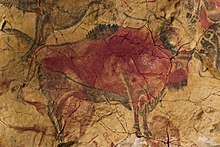You can help expand this article with text translated from the corresponding article in Spanish. (May 2014) Click [show] for important translation instructions.
|
Cueva de Altamira | |
 Magdalenian polychrome bison | |
| Location | Santillana del Mar (Cantabria), Spain |
|---|---|
| Coordinates | 43°22′57″N 4°7′13″W / 43.38250°N 4.12028°W |
| Type | Cave painting |
| History | |
| Periods | Aurignacian–Magdalenian |
| Site notes | |
| Discovered | 1868 |
| Official name | Cave of Altamira |
| Type | Cultural |
| Criteria | i, iii |
| Designated | 1985 (9th session) |
| Part of | Cave of Altamira and Paleolithic Cave Art of Northern Spain |
| Reference no. | 310-001 |
| Region | Europe and North America |
| Buffer zone | 16 ha (0.062 sq mi) |
| Official name | Cueva de Altamira |
| Type | Non-movable |
| Criteria | Monument |
| Designated | 25 April 1924 |
| Reference no. | RI-51-0000266 |
The Cave of Altamira (/ˌæltəˈmɪərə/ AL-tə-MEER-ə; Spanish: Cueva de Altamira [ˈkweβa ðe altaˈmiɾa]) is a cave complex, located near the historic town of Santillana del Mar in Cantabria, Spain. It is renowned for prehistoric cave art featuring charcoal drawings and polychrome paintings of contemporary local fauna and human hands. The earliest paintings were applied during the Upper Paleolithic, around 36,000 years ago.[1] The site was discovered in 1868 by Modesto Cubillas and subsequently studied by Marcelino Sanz de Sautuola.[2]
Aside from the striking quality of its polychromatic art, Altamira's fame stems from the fact that its paintings were the first European cave paintings for which a prehistoric origin was suggested and promoted. Sautuola published his research with the support of Juan de Vilanova y Piera in 1880, to initial public acclaim.
However, the publication of Sanz de Sautuola's research quickly led to a bitter public controversy among experts, some of whom rejected the prehistoric origin of the paintings on the grounds that prehistoric human beings lacked sufficient ability for abstract thought. The controversy continued until 1902, by which time reports of similar findings of prehistoric paintings in the Franco-Cantabrian region had accumulated and the evidence could no longer be rejected.[3]
Altamira is located in the Franco-Cantabrian region and in 1985 was declared a World Heritage Site by UNESCO as a key location of the Cave of Altamira and Paleolithic Cave Art of Northern Spain.[4] The cave can no longer be visited, for conservation reasons, but there are replicas of a section at the site and elsewhere.
- ^ Cite error: The named reference
Pike2012was invoked but never defined (see the help page). - ^ "The discovery of Altamira". Museo Nacional y Centro de Investigación de Altamira. Retrieved 25 September 2018.
- ^ Busch, Simon (February 28, 2014). "Prehistoric paintings in Spain's Altamira cave revealed to a lucky few". Cable News Network. Retrieved December 19, 2016.
- ^ "Cave of Altamira and Paleolithic Cave Art of Northern Spain". unesco. Retrieved December 30, 2016.